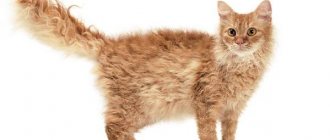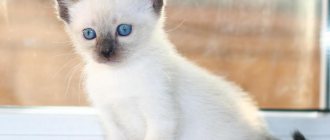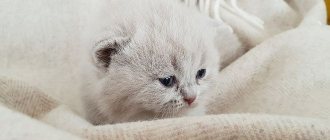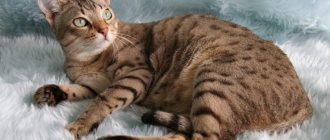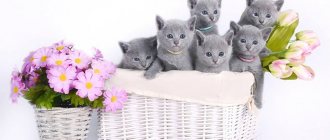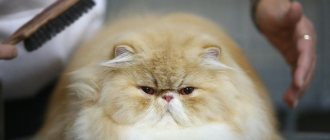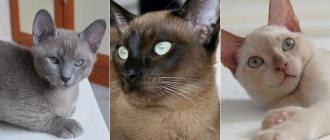Home » Cat Breeds
Classification Origin: was bred in the 60s of the last century in the USA (Pennsylvania)
Class: not classified
Color: white “socks” on the paws are required, the main colors are nut (silpoint), but a blue version (bluepoint) is also allowed, the percentage of white on the body is not higher than 65-70%.
Sizes: medium, males are slightly larger than females, weight from 2.5 to 5.5 kg
Life expectancy: from 9 to 15 years, on average – 12 years
Snowshoe is the cat you can only dream of. Spectacular, graceful, aristocratically restrained. Today we will tell you how to care for the nut beauty.
The snowshu in the photo immediately strikes you with its aristocracy. An amazing cat, everything about her is proportional, there is nothing superfluous.
There is a noticeable great resemblance to the Siamese. This is not without reason: the Snowshoe is a direct relative of the Siamese cat.
The breeds are very closely related, but differ in appearance and character. Let's get to know the “white legs” better.
- 2 Psychology
- 3 Application
- 4 How to choose a kitten
- 5 Features of care
- 6 Combing
- 7 Walking
- 8 Food
- 9 Health
- 10 Characteristic diseases
- 11 Vaccinations
- 12 Mating
History of the breed
The history of the breed began in the 60s of the last century in distant Philadelphia.
Dorothy Hinds-Doherty, a famous breeder of Siamese cats at that time, had one of the breeding females accidentally hanging out with a shorthaired spotted cat.
As a result, three lovely babies were born, looking like Siamese, but wearing charming white “shoes”.
The offspring turned out to be so beautiful and easy-going in character that the owner purposefully decided to breed more of the same kind.
As a result, a new breed appeared, which is still considered experimental; the standard was drawn up in 1980.
Its name “snow-shu” translates as “white shoe” and immediately reminds of something fabulous and magical.
The animal is the same: it amazingly combines soft grace, power, and aristocracy.
The Snowshoe breed captivates at first sight, but, unfortunately, is not particularly popular. Most often it is started in England.
Different color variations of snowshoe
Interesting! The unpopularity of whitelegs is explained by the strictest color requirements. Since recessive genes come out here, breeding pets is similar to Russian roulette: it is very difficult to guess what will happen in the end.
Psychology
Snowshoe kittens have a cheerful, playful character.
They become very attached to people. They have high intelligence and are capable of training.
In these cats you can notice the features of Siamese relatives and dogs: like the Japanese Chins and Pekingese , there is high devotion to the owner, understanding of his psychological state and mood.
Snowshoe kittens
Calm, friendly. Loneliness has a very bad effect on Snowshoe cats. In the photo you can see how the animal likes attention.
In general, they refuse to be alone and prefer to constantly be close to a person.
Ideal for families with children: they easily find a common language and frolic together with the kids.
If the owners go somewhere, leaving the pet alone, then they must be prepared to listen to the sad “story” of the animal about how bad it was.
But, unlike, for example, Burmese and Abyssinian cats , white-legged cats have a pleasant, quiet voice.
Snowshoes love to be photographed
Interesting! Surprisingly, many Snowshoe kittens, and then adults, simply love to swim. They, like Turkish Vans , are not at all afraid of water and can swim in a bath or pond, getting great pleasure from it.
Cats of this breed have a cheerful, playful disposition.
Unlike many other felines, they are not vindictive.
Don't be afraid: the slippers will remain dry, because your pet simply won't settle scores with you.
An affectionate, outwardly very beautiful animal, not at all whimsical in everyday life. And, although he really loves to be petted, he will not bother or impose himself.
Funny baby snowshoe
Interesting! Whitelegs are curious, incredibly smart animals. They easily climb to the highest places, and also, like Scottish Fold cats and Scottish Straight cats , easily master the techniques of opening latches and simple locks.
Therefore, barriers in the form of closed doors most often do not exist for them. In addition, they like to steal things they like and hide them.
In general, an ideal breed for keeping at home, the price of which is quite high, but it is worth it.
The animal is not only attractive in appearance, but also shows itself perfectly in terms of character and intelligence.
You can learn about other smart cat breeds here:
Character
As for the snowshu’s character, it can rightfully be called angelic. Calmness, submissiveness and obedience, which is generally unusual for cats, makes it, as has been repeatedly noted by a variety of people who have ever encountered a snowshoe, incredibly similar to... a person!
Among fans of this breed, there has long been an opinion that cats are not aware that they belong to the cat family and, accordingly, behave with people on equal terms: relaxed and calm.
It is worth noting the devotion of representatives of this breed. The person chosen as the owner of such a cat will not be afraid of loneliness: the snowshu will always follow him, truly supporting him in both sorrow and joy. The cats of this breed themselves cannot stand loneliness at all, and when the owner of the house appears, they will definitely try to “pour out their souls” in a quiet and unobtrusive voice.
Snowshoes are very curious animals. Therefore, the habit of “looking down” on the world around them does not have a self-affirming, but rather a purely cognitive function.
To find out if a snowshoe is right for you, you just need to honestly answer the question - can you give this loving cat enough attention and happily devote some time to communicating with her, without leaving her alone for a long time? A positive answer will mean that this breed is ideal for you. If there are also children in the house who love animals, then choose Snowshoe without any doubt. Usually kids become very attached to cats of this breed. If, however, the Snowshoe kitten is often left without company, it is recommended to get him a “buddy”, preferably of the same breed, so that they do not have to be bored alone.
Application
Snowshoe is a typical home dweller; it is best to keep her in city apartments.
It is easy to train, so you can raise an understanding animal that follows commands and does it with pleasure.
But it is recommended only for experienced “cat lovers” to breed beauties.
The fact is that not everyone succeeds in getting the right color.
The requirements for it are so strict that many kittens are rejected.
Beauty with bright blue eyes
The Snowshoe cat in the photo is a real beauty, reserved and at the same time ready to break into an exciting game at any moment.
By having her at home, you will get a true friend, affectionate and spontaneous.
Many professionals advise purchasing at least a couple of such pets, then the pets will better experience loneliness.
How to choose a kitten
Snowshoe kittens make you fall in love at first sight. They are charming, sweet, very beautiful.
But here it is important not to get carried away and not miss an obvious marriage. To prevent this from happening, carefully inspect the color.
White-legged cats are close relatives of the Siamese cat.
At the same time, the American Shorthair breed .
Breeding was based on recessive traits, which is why correct and clear coloring is so important. Examine the kitten you like.
An ideal representative of the snowshoe, seal point coloring
The basic color is similar to the traditional Siamese, and 2 variations are also allowed - walnut (“seal skin”) or blue.
Moreover, if the animal turns out to be two-color, no more than two-thirds of the entire body should be white.
Now the main signs. In high-quality cats and snowshoe cats, a white triangle on the face, shaped like an inverted V, is clearly visible in the photo.
Another important feature is the white socks on the paws, those same “shoes”.
The ideal option is the same on all four limbs. The eyes are always a pronounced blue color.
The color of the nose and fingertips is either pink or spotted to match the coat.
The color of the tail is uniform, in the same color scheme as the body, but much darker.
The Snowshoe cat in the photo is an ideal representative of the breed, which harmoniously combines all the described characteristics.
When choosing a kitten, consider all 4 signs of breed quality:
- White socks;
- White mark on muzzle in the form of an inverted V;
- Color typical of a Siamese cat;
- Correct physique (massive, but at the same time elongated, graceful).
Only one that combines all of the above characteristics will be considered a truly high-quality Snowshoe kitten.
That is why it is better to take an already grown individual, at the age of 2-3 months.
Focus on character too. Although absolutely all representatives of this breed are sociable and friendly, their activity may be different, this should be taken into account.
Important! The Snowshoe is a fairly rare breed, so you can easily make a mistake and get the wrong kitten. Be sure to study the pedigree. The best option is to meet the parents of the future pet, assess the compliance of the adult cats and the Snowshoe cat with the standards.
Features of care
The good thing about the Snowshoe breed is that it does not require any very complex care.
The main thing is not to leave your pet alone for a long time, communicate with him.
In addition, it is worth brushing the beauty’s fur regularly.
The animal does not particularly need grooming, but if you wish, you can pamper your cat or cat by going to a specialist.
Whitelegs shed little, causing virtually no problems in this regard. By keeping them, you won't end up collecting clumps of matted wool all over the house.
But still, the hairline is quite dense, thick, and requires regular, if not daily, care.
Bathe the animal, many individuals love such procedures.
You can find out more about how to properly wash your cat here:
Important! If a cat has committed an offense, to find it, you just need to open the water. Representatives of the Snowshoe breed simply love to watch it flow. And to reduce theft to a minimum, give the furry criminal a few toys. The cat will gratefully play with them, like a dog, bringing them again and again for you to throw.
A characteristic white triangle is clearly visible on the Snowshoe's face.
In addition to fur, claws require care. Trim them regularly. It is worth purchasing or making a scratching post for an animal - it can also be an element of a cat house .
Keep an eye on your teeth. Experts recommend cleaning them, but not every owner dares to undertake such a procedure.
We advise you to visit a veterinarian: he will not only perform proper cleaning, but will also determine if your pet has any other problems.
Buying a Snow Shoe kitten
Finding a beautiful and healthy kitten with white paws in Russia is difficult. The point is not only the rarity of the breed itself, but also the lack of professional nurseries involved in breeding Snowshoes. On the Internet you can find many advertisements talking about the sale of small snowshoes even in small towns. But there is a risk of running into breeders (these are people who pass off outwardly similar kittens as purebred ones).
Representatives of rare breeds usually cost more than their more popular relatives. There are three classes of purebred cats:
- pet (pet, not for breeding);
- breed (animals recommended for breeding within the breed standards);
- show (intended for participation in exhibitions and competitions - the most expensive).
A pet-class white-legged kitten costs at least 15,000 rubles, and a show-class baby will cost more than 50,000 rubles. The same kittens may have a lower price, but without a pedigree, with a slight physical defect or with a deviation from the breed standard. Usually Snow Shu girls are more expensive than male cats, this is due to the fact that the female cat, having matured, will be able to bear offspring. In any case, in order not to make a mistake, you need to find a bona fide breeder or an officially registered nursery by studying the reviews and recommendations of former clients.
Finding a snow shoe in Russia is difficult
Criteria for choosing a Snowshoe kitten
When visiting the nursery in person, you need to pay attention to the following signs:
- appearance of the animal;
- kitten behavior;
- passport and pedigree;
- breed characteristics.
Externally, a Snowshoe kitten should be well-groomed and beautiful, without traces of parasites on the body, wounds or scratches, with clean eyes and ears, pink and smooth oral mucosa. The baby should be active and playful, but not aggressive. Try to determine how cheerful the kitten is and how it communicates with other kittens. Whitefoot can be modest and a little shy, but not cowardly. She also shouldn’t sit sluggishly and apathetically in the corner. The cat may be hyperactive and noisy, but this is not a drawback. The future owner just needs to take into account the fact that the baby will grow up to be a mischievous cat.
An equally important factor is the availability of documents. Each cat of this breed must have a veterinary passport and pedigree. All marks in the passport must be certified by the signature of the veterinarian, the seal of the veterinary clinic and a holographic sticker. The pedigree must indicate the kitten's parents, breed, as well as “unsuccessful” litters. This is necessary so that the future owner can evaluate the possibility of the cat’s participation in breeding. You must be sure that the kitten is purebred and the pedigree is real, because the Snowshoe is a rare and therefore expensive breed.
The pedigree must be original (with a color stamp)
The animal must meet breed standards. The main features are a stocky body, a short and thick neck, and gray-blue eyes. The Snowshoe's color may be white (or almost white) at birth; it will darken as it grows. However, sometimes marks begin to appear almost immediately after birth (the tail and ears are dark, the nose and paws are white). If you need an ideal representative of the breed, and not a “couch” companion, then you can contact an independent expert.
Chat with the breeder. An honest breeder who has something to be proud of will not hide anything about the kids. He himself is interested in the kitten’s successful finding a new family. The owner of the cattery should tell you about vaccinations, castration, possible diseases, etc. Don’t hesitate to ask - the breeder can advise you on how and what to feed the cat, what things he needs. In a good nursery, along with the kitten, they can give you not only documents, but also the animal’s belongings.
One day I was choosing a kitten in a nursery. I didn’t hesitate to ask, and the breeder was happy to tell everything. It seemed to me that he liked it when they asked him in detail about the maintenance of the kitten. Along with our passport, we were given toys, half a bag of fine litter, a small supply of food and souvenirs with a photograph of the animal.
What age is the best kitten to choose?
Until 1 month, kittens cannot feed on their own - they are fed by their mother. She instills immunity in them (the kitten receives antibodies through the cat’s colostrum). Only a mother can teach babies to communicate with each other and with people, helps them master the tray, scratching post and toys - they follow her example in everything.
If you take a kitten at the age of 1 month, then it may have problems with the digestive system, since the functioning of the gastrointestinal tract will be affected by a sharp transition from one diet to another. Problems may also arise with other systems of the body, which, having ceased to receive antibodies, will be susceptible to infectious diseases. In addition, if a kitten is taken away from its mother too early, it may become stressed and develop mental problems later in life. Such kittens usually grow up to be too timid or, conversely, too aggressive. It will be difficult to train such a pet to the tray, because he does not know that now he must obey the person.
It is not recommended to take home a kitten under three months of age.
At the age of 1-2 months, a kitten can be adopted only in one case - if its mother gets sick or dies. But this exception only works if you can provide your baby with decent care and proper nutrition. If everything is fine with the cat’s mother, and you are simply afraid that someone else will take a particular kitten, you can reserve it. Some nurseries practice the armor system. This way you can secure your right to receive a specific animal. True, then you will need to pay some part of the amount.
One day, dad brought a white fluffy kitten, who was barely a month old. He walked unsteadily, although he looked quite strong. He was already feeding himself (lipping milk from a saucer), but after a couple of days he became ill. He stopped eating and getting up. We called the veterinarian, but by the time the doctor arrived, the kitten had already died. It turned out that the baby fell ill with the plague. The disease manifested itself abruptly, so we did not have time to help him.
Whether the kitten will be healthy depends on the age at which you pick up the kitten.
Professional breeders do not give kittens to new owners before they have given the baby the necessary vaccinations (even if the cat has already been reserved). The first vaccination is carried out at 12 weeks; the baby’s life depends on these vaccinations. Therefore, if the breeder gives away the kittens earlier, he will break all the rules. Thus, the optimal age to adopt a kitten is from 12 weeks (3 months).
Video: everything about the Snow Shoe breed
Walk
The pet can be trained to walk with its owner, and the furry beauty does not mind a special cat collar.
On the street he behaves inquisitively, sniffs everything, quickly gets used to it and stops being afraid.
To avoid tick a protective collar on your pet .
Since the animal is a contact animal, you should never let it off the leash.
And one more condition: do not let your pet go for a walk with children. You can easily lose a rare pussy.
Curious cats
A more convenient option is to release the cat into the wild if you have a summer house.
The animal will actively explore the world without being afraid of it at all.
But keep an eye on him: he can easily run away.
Nutrition
In order for your Snowshoe cat to look as healthy as in the photo, it is important to feed it properly.
A balanced diet is the key to a long life and active behavior of an animal.
Healthy, beautiful white leg
Buy special food , and dry food can sometimes be varied with wet food.
We also recommend adding other foods: fresh green grass, boiled eggs (rarely), meat, fish.
If you don’t trust store-bought food and prefer to feed your pet only natural food, then be sure to include in your diet:
- Egg yolk (it is advisable to mix it with milk);
- Fermented milk products (exclude cream and sour cream; instead, kefir, fermented baked milk, yogurt are better);
- Raw oatmeal added to a main meal;
- Fruits and vegetables (raw or boiled);
- Sprouts of oats, wheat (sow in a pot, the cat will eat itself when needed, this will help her clear her stomach of hair);
- Special cat vitamins, in strict doses;
- Fresh meat, sea fish (obligatory boiled).
Nutrition for an animal is very important; it helps to maintain health and vigor.
Watch your drinking carefully: water should always be fresh and clean.
Important! Feeding a kitten is different from what is needed for adults. The baby should be given small portions, but often. As they grow, the volume should be increased and the number of feedings should be reduced. By the age of one year, the animal can be given food once a day, but so that it will last for a day.
The price of food varies, and here it is better to choose not expensive, but high-quality food.
We do not recommend giving only dry food, it can ruin the cat’s digestion.
Combine with wet options, or even better, with natural foods.
Also pay attention to the condition of your pet: there are special foods for animals during pregnancy , neutered and elderly cats.
Keeping a Snow Shoe cat
Snowshoes are curious animals, they always stick their nose into places where it is not safe. Therefore, the future owner needs to provide for everything: install screens on the windows, hide visible wires, remove all fragile things, medicines and valuables. If a new pet spoils something, it won’t be his fault - the owner just didn’t foresee something. In addition, the white leg can harm itself (cut itself, get poisoned, fall out of a window, etc.).
An essential item is cat litter. Snowshoe will quickly remember where the tray is and why it is needed. Fill this tray with the litter your breeder gave you, or buy a new one. For small kittens, you need to choose a special baby litter (it does not stick to their paws and does not spread around the apartment). As your pet gets older, it will be possible to replace the children's litter with an adult one (with medium or large granules).
The new owner of a snow cat should prepare his apartment in advance for the pet to move
The animal also needs a house and/or a bed. It is better to install the sleeping place at a certain height from the floor, otherwise the cat may choose a more comfortable place from where it can see the entire apartment. It is better not to place the bed near the radiator (dry and warm air can dry out the animal’s coat). You will also need toys. Whitelegs love to play, so there can be a lot of toys (let them be simple, but safe and interesting).
White-footed cat nutrition
Snowshoe cats can be fed commercial food or natural food that the owner will prepare especially for his pet. Dry food must be the best quality you can purchase. Cats prefer wet food (canned food), but dry food is still considered healthier. Store-bought food is specially designed for cats, so it already contains all the necessary microelements and minerals on which the health of your pet will depend. The main requirement for food is that it must be of high quality and fresh.
My cat “grows up” on a mixed diet. From industrial food, I buy dry food for cats up to 1 year old. Our veterinarian told me that dry food is good for teeth. Every time I make a purchase, I check the expiration date and composition (I try to avoid food on the packaging of which I find the names of unfamiliar ingredients). I usually “fasten” the opened package with a clothespin, and store the package itself in the kitchen cabinet (far from the battery). A large package seems good for the price, but such a volume of food can spoil even before the cat eats it. Therefore, I usually choose medium-sized packages.
The cat owner must ensure that the pet eats the best food
Quantity and composition of natural food
Natural food is not the same as food from the table. A cat should not eat what its owner eats. Any dish that will be offered to a cat must be prepared specifically for it and taking into account its needs. The diet must be varied, protein-rich and tasty, otherwise the animal may refuse to eat. Snowshoe food should be prepared from the following products:
- meat - beef, turkey and chicken, boiled or frozen (the dish should consist of half meat);
- chicken and turkey by-products - stomachs, hearts, wings, necks, etc. (offal can replace some of the meat);
- fish - salmon, cod, salmon (no more than 1-2 times a week in small quantities);
- vegetables - cabbage, cucumbers, tomatoes, carrots, etc. (can be used as a side dish for meat);
- fruits - any, except exotic ones, because they can cause allergies (in small quantities, for example, as a delicacy);
- low-fat fermented milk products (cottage cheese, sour cream, yogurt without additives);
- cereals - buckwheat, rice, semolina, rolled oats (you can steam the porridge and serve it with meat).
To keep your cat's food from being too expensive, you can resort to some tricks. For example, I prepare meat and fish in advance. I boil the fish, separate it from the bones and freeze it in portions. I also freeze the meat, but not raw, but after cutting it into small cubes (about 1x1 cm). Portions can be defrosted one at a time - this will save time. In addition, I don’t go to the store specifically to buy meat for my cat, but cut off a piece of flesh every time I buy meat for myself.
Clean water should be in the bowl at all times. By the way, it is better to purchase bowls made of ceramic or metal. Plastic cookware wears out quickly, and its inner walls become rough and scratched. Pathogenic microbes can settle in these scratches.
The Snowshoe cat's menu should consist only of approved products.
The cat owner also needs to remember the list of foods that are not recommended to be given to pets:
- pork (it may be infected with parasites);
- river fish (it may contain parasites and many small bones - the cat can damage its esophagus);
- milk (not absorbed by the cat’s body);
- potatoes (eating starchy foods can raise blood sugar levels);
- any spices (salt, pepper, etc.);
- fatty and fried foods;
- saltiness and smokedness (including sausage);
- sweets (harmful to cats’ teeth, and some of them may be allergenic).
How many times a day should you feed your pet?
Small kittens are fed 4-5 times a day, by six months the number of feedings should be reduced to 3-4. In this case, the serving size needs to be increased. Gradually, this number of feedings needs to be reduced. It is recommended to feed cats over 1 year of age twice a day.
If you feel like your pet is not getting enough to eat, there is no need to increase the frequency of feedings. You can provide your cat with additional food in the form of special cat grass (oats, alfalfa, etc.). It's inexpensive, cats love oat sprouts, and this kind of grass contains a lot of fiber, which is good for digestion.
Snowshoe cats are rarely thin
Snow Shoe grooming
Whitelegs are neat and tidy. They do an excellent job of hygiene, but the owner must look after the cat and help it. Appearance care consists of several parts:
- cleaning your ears once a week - this requires cotton swabs and special oil;
- daily wiping of the eyes with cotton pads if dirt accumulates in the inner corners;
- trimming the claws once every 2 weeks - a nail clipper or tweezers are suitable for this, which only cut off the transparent tip of the claw;
- brushing your teeth with a special toothpaste and a small toothbrush;
- brushing and bathing.
Not a single cat enjoys brushing its teeth, but this should be done at least once a month. Indeed, this is a complex procedure, because you need to force the cat to open its mouth, and this is not so easy to do. If you don't brush your teeth at all, tartar can form on them. Diseases of cat teeth are dangerous, since their treatment can only be done under anesthesia. To prevent dental diseases, you can purchase special treats for cats (for example, in the form of a bone).
My sister's cat (Donut) is terrified of toothbrushes. This may be due to the fact that his gum may have been injured by a brush at some point. They bought special treats for Donut, but he refused them. Manufacturers add some substances (like flavor enhancers) to these treats, but this cat is too selective in what he eats. Now Donut is 2 years old, his sister takes him to the vet every 3 months. At the clinic, his teeth are cleaned and his claws are trimmed at the same time.
Cats don't like brushing their teeth or trimming their claws
Brushing and bathing a snow cat
The short fur of the Snowshoe does not require special care, but sometimes it still needs to be combed. A massage mitten or a brush with natural bristles is suitable for this. Combing allows you not only to remove dead hairs from the undercoat, but also to massage the skin, thanks to which a protective layer of natural fat is distributed throughout the coat. In addition, white-legged cats love to be brushed (if you do not use a furminator, slicker and other “scary” objects), although they do not shed much.
I comb my pet with a massage mitten with soft silicone teeth. At first the cat was afraid of it - the rubber sole of the mitten seemed to “stick” to the hair (I tried it on myself), this is how excess hair is removed. In addition, in the first few days after purchase, the mitten smelled unpleasant (chemical smell). I washed the mitten, and when it was dry, I spread catnip on the bottom of the mitten. Of course, my cat couldn’t resist the smell from the “strange” object, she even tried to chew it, but then she got used to it. It is convenient to process short fur hairs with such a tool, and the cat thinks that it is being petted.
Many snowshoes love water, so there will be no problems with water procedures. When bathing your pet, you can only use special shampoos and conditioners designed for cats. The whitefoot will try not to get out of the bath for as long as possible, so the owner will need to monitor the water temperature. Keeping a cat in cold water is dangerous for colds. It is recommended to arrange a bath day no more than once every 3 months. The owner should be prepared for the animal to look for water.
Video: Snow Shoe looking for water
Health
The Snowshoe cat looks healthy and cheerful - it’s all about proper care of the pet
The good thing about this breed is that it has virtually no concomitant diseases.
It is believed that with proper care, white-legged animals live fully into old age, practically without being exposed to any diseases.
If you are interested in looking at the scariest cat in the world, we recommend that you read the article
Still, you should take your pet to the veterinarian to immediately identify possible or existing problems.
In general, we can say that these are healthy, strong, active animals.
Characteristic diseases
The Snowshoe breed has practically no characteristic diseases.
If any problems may arise, they are only related to heredity.
There are not so many of them, and they are not as scary as other breeds:
- Strabismus. Usually congenital, inherited from Siamese relatives, rarely detected in kittens;
- Tail break. This is more of an external defect than a serious illness. It is also inherited from the Siamese.
No other health problems were noticed in the snowshoe.
Experts advise taking your animal to the veterinarian once a year so as not to miss any diseases, and for individuals over 8 years old - once every six months.
Castration and sterilization of Snow Shoe
If you do not plan to get offspring from your pet, then it can be castrated or sterilized. Veterinarians recommend sterilizing a cat before the first heat (at about 7–8 months), but most often cats are operated on at the age of 1–1.5 years. A cat can give birth 3-4 times a year, if it is not sterilized, the owner will have to decide something about finding a partner, and then about kittens. One way or another, the issue of sterilization will still arise someday. If a cat goes into heat and does not mate, then her body may malfunction. Such abstinence can lead to serious diseases of the reproductive system.
Males are usually operated on a little earlier than females (up to 1 year). A cat does not go into heat, but a couple of times a month he may experience a wild need for a female. When a cat cannot satisfy his instincts, he becomes nervous and noisy, he will scream heart-rendingly and mark his territory. Contrary to popular belief, neutered cats do not become lazy or indifferent. Such animals will be calm and affectionate, but prone to obesity, so if the owner begins to overfeed his cat, then the fairly plump pet will not be able to rush around the apartment and play with the ball.
Now veterinarians perform operations as painlessly as possible and with virtually no risk of developing postoperative complications. Plus it's inexpensive. I gave my first cat for sterilization for 1,500 rubles (back then there weren’t as many veterinary clinics as there are now). The cat that lives with me now was sterilized for 600 rubles. All standard operations follow the same scenario: abdominal surgery, the intervention lasts 15 minutes, stitches are applied. But now you can order laparoscopic surgery (intervention through a small puncture), where you don’t even have to put stitches. I heard that cats are operated on even faster, and stitches are almost never required.
Video: recommendations for postoperative care
Vaccinations
The Snowshoe breed requires routine vaccinations for animals, according to a standard schedule.
A kitten should be comprehensively vaccinated for the first time at the age of three months.
The procedure is then repeated every year.
In rare cases, the animal may be given an individual vaccination schedule .
Naturally, 10 days before the proposed vaccination, the animal should be dewormed.
Important! You cannot vaccinate kittens during the change of teeth (this is a period from 4 to 6-8 months), pregnant cats, and individuals with weakened immune systems.
Carefully monitor your pet's health.
At the slightest suspicion of any disease, it is best to immediately consult a specialist.
Video
* We invite you to watch a video about the Snowshoe . In fact, in front of you is a playlist in which you can select and watch any of 20 videos about a given cat breed by simply clicking on the button in the upper right corner of the window. In addition, the material contains quite a lot of photos. By looking at them you can find out what Snow-shu looks like.
Rate the material!
[Total votes: 1 Average: 5]
Any person who is partial to cats understands that all breeds have a lot of their own characteristics, and each specific pet has its own character traits and qualities unique to it. Such nuances are always important to consider when choosing a furry family member. After all, any breed has some subtleties, including the snowshoe .

